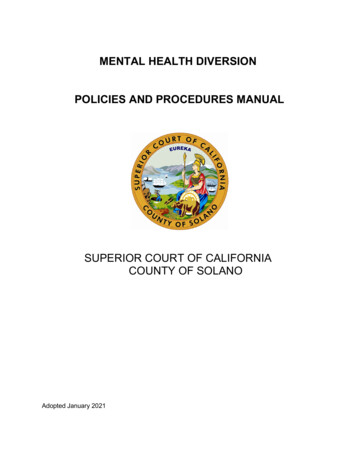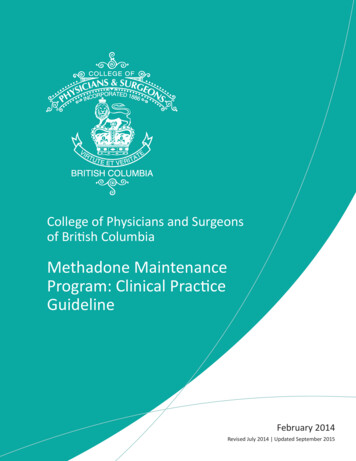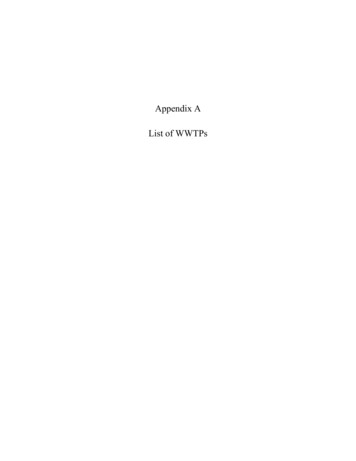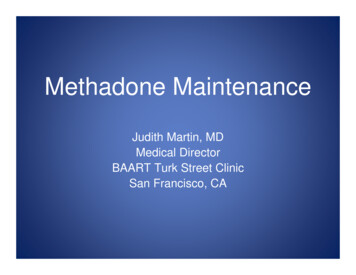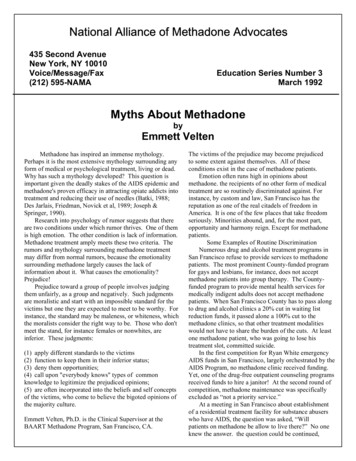
Transcription
If you have issues viewing or accessing this file contact us at NCJRS.gov.,I0,1J'!'.I" ', i4.- W'7''9Y. '.National Institute oil Drug Abusei. ; :. Experlenees .and Issaes.JU.S. DEPARTJIJIENT OF HEALTH, EDUCATION, AND WELFAREPublic Health SElrviceAlcohol, Drug Abuse, and Mental Health Administration
.h.'" RSION:Experleneesand IssuesBYJames A. Inciardi, Ph.D.Division of Criminal JusticeUniversity of Delaware, ,U. S. DEPARTMENT OF HEALTH, EDUCATION, AND WELFAREPublic Health ServiceAlcohol, Drug Abuse, and Mental Health AdministrationNational Institute on Drug Abuse11400 Rockville PikeRockville. Maryland 20852
, "I,,\' ,"The Services Research Reports and MonographSeries are issued by the Services ResearchBranch, Division of Resource Development,National Institute on Drug Abuse. Their primarypurpose is to provide reports to the drug abusetreatment community on the service delivery andpolicy-oriented findings from Branch sponsoredstudies. These will include state of the artstudies, innovative service delivery models fordifferent client populations, innovative treatment management and financing techniques, andtreatment outcome studies.This manual is a product of NIDA contract # ADM-4S-74-l2S,which was developed in 1974 to study the nature and scope ofmethadone diversion in the United States.The material contained hereinopinions, official poUcy, oron D Abuse of the Alcohol,Administration, PUblic HealthEducation, and Welfare.does not necessarily rejtect theposition of the National InstituteDrug Abuse, and Mental HealthService, u.S. Department of Health,DHEW Publication No. (ADM) 77-488Printed 1977For sale by the Superintendent 01 Documents, U.S. Government Printing Omce\VashlDgton, D.C. 2Ot02Stock No. 017-G2' 1&-7ii,I!'
FOREWORDThe extent and consequences of the diversion of methadone to the community from licit sources have long been a source of controversy and concernwithin the drug abuse treatJlKmt community. It is widely recognized that diversion of methadone at some level is an unfortunate consequence of attempting to provide methadone treatment to the 85,000 persons now receiving suchtreatment. The extent and the nature of that diversion, however, have beenimperfectly understood, as has the role that uSe of illicit methadone playsin the drug abusing community.The National Institute on Drug Abuse arranged to make study of some ofthe issues around methadone diversion through contracts with Dr. John Martinand his staff at Fordham University and with Dr. James Inciardi of theUniversity of Delaware. Dr. Inciardi's work represents an effort to describethe phenomenon of methadone diversion as it exists now and to place it in thecontext of prior research in this area. This report is intended to clarifyissues around methadone diversion and to provide guidance to treatment administrators and program planners regarding efforts they can initiate to monitorthis significant phenomenon.Laurence T. Carroll, Ph.D.DiroeatoroDivision of Resource Developmentiii
CONTENTSPageI.II.StMfARy1INI'RODUCrION71HE DEVELOPMENT OF MErnADONEAND ME1HADONE TREATMENT9 III.Methadone T'l"eatment91HE EMERGENCE OF ME'X'HAOONE DIVERSION The General Diversion of LegalMethadone to an Illicit DrugMarketplaceMethadone AddictionMethadone SupplementationMethadone Overdose.IV. CURRENI' PERSPEC'fIVES ON 1HE NA11JRE ANDSTRUCTURE OF ME1HAOONE DIVERSION121216171820;.Diversion, II: A Study inFive Cities21 212323243035Methad net Project Design StrategyAreasSample CompositionFindings--Street PopulationsFindings--Program PopulationsFindings--Law Enforcement InquiryTar et National Data Systems CODAP38DAWN39V. APPROPRIATE MEASURES OF MB'IHADONEDIVERSION Methadone Overdose 'DeathsDrug Program'Admission Data; CODAPDAWNDrug Seizures and ArrestsChemical Traces"1v414143454748
CONI'ENTSPage Drug Thefts Short-Term Field Studies5051References54Appendix A: TablesAppendix B:Formsv
Sur 1ARYMethadone is a synthetic narcotic drug currently used as one of theprimary mechanisms for the treatment and detoxification of heroin and otheropiate addictions. Methadone was synthesized in Germany during World War IIand, within a year after its release for study in the United States, researchdemonstrated the drug had an addiction liability and abuse potential. Theliterature suggests that addiction to methadone was noted as early as 1950and that a methadone black market had emerged prior to 1960. Methadone maintenance, as a modality in the treatment of narcotic addiction, was developedduring the mid-1960's by Drs. Vincent P. Dole and Marie E. Nyswander in NewYork City. By the close of that decade, methadone maintenance had becomewidespread as a part of addiction treatment.The initial public statements on methadone diversion appeared in 1969,only one year after the Do1e-Nyswander approach had begun to expand beyondNew York City. By the early 1970's, enough reports of the illicit use of thedrug had emerged to suggest that its diversion might be growing, thus warranting immediate investigation of several specific questions: How extensive and consistent was methadonediversion? How readily could methadone be diverted frommaintenance programs? What purposes did methadone diversion serve?In an effort to answer these questions, the National Institute on DrugAbuse contracted with the Institute for Social Research at Fordham Universityfor a study of methadone diversion in five cities. After extensive interviewing in the cities of New York, Philadelphia, St. Louis, Nfiami, and San Juanduring 1972-73, it was concluded that methadone was readily available on thestreets of all five cities. The data indicated that the drug was generallydiverted from maintenance programs by the patients themselves and that themost available form was methadone in the liquid vehicle. Finally, the studysuggested that the majority of the street use of methadone was therapeuticallyoriented, in that it was t) ically a technique to check withdrawal or to detoxify.After more rigid controls over take home medication were promulgated bythe Food and Drug Administration in March 1973, a second study of methadonediversion was undertaken by the researchers at Fordham University. Thissecond effort was undertaken during 1974-75 in the cities of New York,Philadelphia, Detroit, San Francisco, and Washington, D.C. A total of 599active street addicts and 725 methadone maintenance patients, as well as numerous representatives of the criminal justice system, were interviewed at1
length, and the data elicited from these sources are reported below in sum-mary form. l Availability. Illegal methadone was reportedly available in thefive cities studied. Among the 599 active street addicts contacted, for example: 46 percent (n 275) reported using illicit methadoneduring the week prior to interview., 70 percent (n 418) reported using illicit methadoneduring the 3 month period prior to interview.In addition, some 64 percent of the street sample and 63 percent of thepatient sample stated that the drug could be readily obtained. Furthermore,in New York and Philadelphia where studies were undertaken in both 1972-73and 1974-75, the data suggested that methadone was more available during thesecond study period than the first. For example: In New York, 38 percent of the street sample reportedusing illicit methadone during the week prior to interview in the 1972-73 study and this proportion increasedto 50 percent during the 1974-75 study. In Philadelphia, 9 percent of the street sample reportedusing illicit methadone during the week prior to interviewin the 1972-73 study and this proportion increased to 63percent during the 1974-75 study Freguency of Use. Methadone did. not appear to be a widespread majordrug of abuse. In fact, among the street sample of 599 subjects, methadoneranked low when the question was asked, ''What are you mainly on?" Forexample:N 599 .' heroinmarihuana/hashishcocainemethadoneall other/no data84%4%4%4% .Furthermore, 9S percent of those reporting illicit methadone use during the3 month period prior to interview (n 418) indicated such use at less thandaily. Of the 'remaining 5 percent (n 20) who did use the drug daily, onlyhalf (n 10) reported use at more often than once a day.IThe majority of the figures in this Summary relate to the street populationinterviewed, since their activities reflect the most current use of illicitmethadone.2
Form of Use. Metr done in the liquid vehicle was found to be themost commonly used form of illegal methadone. There were a total of 527street addicts and 510 patients who reported having experience with streetmethadone. Some 97 percent of these street addicts and 89 percent of thepatients indicated that they had used diverted methadone in the liquidvehicle. Furthermore, 85 percent of the total street sample and 64 percentof the total patient sample stated that the drug could be purchased in theliquid vehicle. Price. The price structure of illegal methadone appeared to be generally uniform in all cities, at 6.00- 10.00 per dose in the liquid vehicle. Source of Illicit Methadone. Patients in methadone maintenance programs were overwhelmingly reported as the primary source of the drug. Some85 percent of the street sample and 81 percent of the patient sample suggested maintenance patients as the primary vehicles of diversion. Only a minimumof diversion was suggested to occur through program staff or physicians, yetsome trafficking in the d g was reported to occur through special methadonedealers and drug pushers. Reasons for Use. The primary reason for illicit methadone use wasreportedly tfierapeuticln nature. Among the 527 street addicts and 510patients who had experienc(, with street methadone, their responses in this behalf were as follows: totototoavoid wi thd,rt\wallimit habittemporarily detoxifypermanently d\ toxifyStreetPatient58%37%37%17%( 4%30%33%27%.Regarding the euphoric qualities of the drug, 38 percent of the street addictsand 35 percent of the patients who had experience with street methadone reported having used the drug "to get high." It should be added here that thetherapeutic role of illicit methadone in the self-treatment of addiction hasbeen found throughout the literature. Among 145 illicit methadone users admitted to the National Institut ' of MElnta1 Health Clinical Research Center atLexington, Kentucky during 1971, 53 percent indicated self-treatment as theprimary reason for use (Weppner, Stephens, and Conrad 1972) The study of53 street methadone users by Chambers md Inciardi (1972) reported that 58percent had used the drug for self-treatment. The Washington D.C. studyV; there were a total of 1,741,256 dosage units of methadone that were lost or stolen. It is likely that this type of phenomenonmight account for the distributior of illicit methadone through special dealers. It might also be noted here that in addition to the U.S. sources of thedrug, methadone is also produced in dozem; of forms in Germany, Czechoslovakia, the U.S.S.R., and numerous c,ther countries (see Usdin and Efron 1972:372-373). It is not known if any of these foreign-made products are reaching the U.S. black market.2As noted in Chapter3L --
of five samples during 1972-1975 found. that 79 percent of the subjects hadused illicit methadone for therapeutic purposes (Greene, Brown, and DuPont1975). Law Enforcement Inqui . Law enforcement officials at both Federaland local levels place a low p ority on methadone diversion, in part because it lies outside the illegal distribution system, and this may be reflected in the limited number of illegal methadone seizures.'. Indices of Methadone Diversion. A number of possible indices ofmethadone diversion were examined--overdose death data, drug program admissions data, CODAP, DAWN, hospital emergency room data, drug seizure andarrest data, chemical trace data, drug theft data, and short-term field studydata. It can be generally concluded that most of these data sources havelimitations and could not stand alono as reliable indices of diversion, yetthey can represent relative-partial indicators of the existence of methadonediversion in given conmn.mities. These data, however, cannot generally provide specific information on the availability of diverted methadone 'and thedynamics of the methadone black market. Chemical traces, elicited by"tagging" the methadone dispensed in maintenance progra. s and analyzing seizedsamples of the drug for this trace, are of limited utility in targeting thesources of diversion, since the incidence of illicit methadone seizures isrelatively low. Short-term field studies and studies of program admissionswould appear to be a promising mechanism for compiling on-going, economical,rapid and cross-sectionally representative data on methadone diversion.Perhaps the most fruitful mechanism for monitoring lnethadone diversionwould be the combined data from the suggested infonnation network, CODAP, andDAWN: Community and treatment program data would provideinfonnation on availability, source, price structure, and relative prevalence in given conununities. CODAP data would provide prevalence estimates ofillicit methadone use among recent users seekingtreatment across the nation. DA data, given some additions to the current reporting process, would sup lemellt prevalence estimates in terms of that population exposed·to acute,adverse, and fatal drug reactions.Lastly, some conunent seems warranted regarding the negative vs. ositiveaspects of methadone diversion. The negative as ects have included t e potential for methadone addiction and the risk of overdose, while the positive aspects circumscribe the therareutic role that illicit methadone plays in theactive street conununity.Addiction to black market methadone in contemporary drug-using communities is a phenomenon that has not been widely documented. The 1974-75Fordham data, as noted earlier, indicated that as little as 3.7 percent4
(n 2: ) of the street population reported illicit methadone to be theirmajor drug, only 3.3 percent· (n 20) of the population reportedly used methadone on a daily basis, and only 1. 7 percent (n 10) reported the use ofmethadone more than once a day. Furthermore, since the majority of the streetpopulation reported the use of illicit methadone for therapeutic purposes, itmight be assumed that a portion of these daily users were regularly i olvedwith the drug to avoid withdrawal, to 1tmit their habit, to detoxifY, or tokeep themselves stabilized until they got into a treatment program. Some9.4 percent (n 49) did claim that th 1 had been addicted to methadone, butthere is no indicati.on in the data as to whether all of these ividua1Swere addicted at the same time, or when that point in time was.The risk of acute or fatal reactions to illicit methadone is anotherissue that requires further study. Our data on this phenomenon are drawnfrom the DAWN system which, as noted. earlier, has several limitations. Inspite of these, however, DAWN data nevertheless reflect relative indicatorsof methadone risk potentials. Initially, during the period July 1973 throughJune 1975, there were 2,083 methadone-related deaths reported from the 24SMSA's reporting to DAWN. However, 2S percent of these deaths also involvedheroin and almost 50 percent also involved at least one other drug. MOre important1y, since the fOUI'th quarter of 1973, when methadone-related deathshit a peak of 304, the number of deaths has decreased by 43 percent J to 212in the second quarter of 1975; during the same periOd of time, heroin-relateddeaths increased.by 23 percent, from 395 to 512 (National Institute on DrugAbuse 1976). secondly, in tenns of the number of methadone-related emergency room episodes reported to DAWN from July 1973 through June 1975, there wasa decrease of 15 percent (from 2,384 to 2,068), while those of heroinincreased by 29 percent (from 4,636 to 6 t 546). While the data indicate therelative prevalence of acute and fatal reactions to methadone, they also indicate that these are declining.The positive aspects of illicit methadone, as noted earlier, circumscribethe role that the drug plays in the self-treatment of addiction by the majori ty of its users Purthennore, as others have noted (for example, Agar1974), with heroin, control over large quantities has traditionally rested inthe hands of a few major suppliers, thus contributing to its unstable yethigh price; with methadone, eacfl of its many sources controls a small amount,ap arent1y making it less costly. Additionally, the availability of an inexperience longer-lasting narcotic tends to reduce some addicts' hustling activity. Finally, the predominantly oral route of methadone administrationreduces the medical problems related to the intraveneous injection of heroin.1********Chapter I of this report reviews the background of issues, including theintroduction of meth one into the society and the subsequent recognition of;)Agar and Stephens (1975) reported in a 1974 study of New York clddicts thatthe emergent role of methadone was one of primary abuse. The authors cautioned the interpretation of their data, however, since mulCh of it was basedon estimates from a small sample of 41 street addicts.5
::v--"\',"";"",a potential problemin the illicit diversion of the druS to lUls erv'ised.use. Chapter II'offers a brief historical overvlewof the factorswhich led to the development of methadone and the institutionalization inthis co try of methadone treatment. Chapter III examines the early studieson methadone .diversion Olapter IV provides an analysis of the Fordham data,highlighting its findings and conclusions. 111is chapter also examines current national data systems regarding methadone diversion. Finally, drawingon these findings, other data fran the drug literature, and additional information specifically collected for this publication, chapter V examines avariety of measures that might be utilized for assessing the nature and prevalence of methadone diversion in a camamity.stree 6
HU.S. Government Printing OfficeSuperintendent of DocumentsWashington, D.C. 20402THIS IS NOT A BILLPO DA-0'8350-2'NATIONAL CRIMINAL dUSTICE REf.SEVICE, ACQUISTIONS DEPT.BOX bOOOROCKVILLEMD20850LDbb858l0.Jl-METHAPONE DIVERSION, EXPERIENCES AND ISSUESOl7-02'1-00blS-7U3PLEASE SEE REVERSE800l8BDZ7D'Z
GPO FOAM 3832 (A 3·79)DEAR CUSTOMER:WE HAVE FOUND THAT MAILING DIFFERENT PUBLICATIONS AS SEPARATESHIPMENTS SPEEDS THE PROCESSING OF ORDERS TO YOU. IF YOURORDER CONTAINED MORE THAN ONE TITLE, YOU MAY EXPECT TO RECEIVETHE REMAINING TITLE(S) AS SEPARATE SHIPMENT(S).Credit Card and/or Deposit Account Sales will be reflected on your monthlystatement. Include your Deposit Account or Credit Card number with expirationdate on all inquiries concerning your order.ALL SALES ARE FINAL: We do not accept the return of publications for exchange or credit unless an error was made by this Office in filling y"ur order.All claims must be submitted within one year from date of your order. PLEASEDO NOT RETURN PUBLICATIONS UNLESS NOTIFIED TO DO SO.If a shipment Is incorrect, please return the card in question with your requestfor adjustment to this Office.
METHADONE DIVERSION:EXPERIENCES AND ISSUESIINTRODUCTIONMethadone is a synthetic narcotic drug with analgesic, euphorigenic,and dependence producing qualities that represents one of the primary mechanisms for the treatment of heroin addiction. The pharmacological basis of itsuse in treatment rests on the notion that methadone intervention can restrainthe phenomenally untoward effects of morphine-like drugs by substitution.The pharmacologic considerations that influenced the development ana expansionof methadone maintenance therapy included the following: Methadone reflects many of the characteristics of morphine,including cross-tolerance; a person tolerant to one morphine-like drug is also tolerant to equipotent doses of another. Methadone, when administered to a heroin addict, willeither prevent the withdrawal symptoms caused by abstinence from heroin or eliminate them if they have alreadydeveloped. The action of oral methadone lasts up to twenty-four hours;a methadone program can administer the drug once a day,rather than three to four times as would be necessary inthe case of heroin or morphine. High doses of methad.one will prevent withdrawal and blockthe euphoric effect from an injection of heroin. High and low doses of methadone will prevent withdrawal,as well as "drug hunger," that is, the feeling of physicalabnormality felt by addicts who have become abstinent. Methadone carl be administered orally and is medicallyhaving minimal significant side effects.saf ,When methadone maintenance was initiated in the mid-1960's as an approachto the treatment of addiction, many hoped that a "cure" for the chronic relapsing disease of narcotic dependence had finally been achieved. Thus, ifaddicts were properly maintained on methadone, their drug-craving would cease,their illicit drug taking and drug-seeking activities would become unnecessary,and the rehabilitative services offered by treatment programs could respond tothose psychosocial problems which had initially led to the use of drugs.Shortly after programs began to proliferate across the nation during thelate 1960's, the difficulties associated'with methadone maintenance treatment7
began to surface. Program retention rates were not as high as had been anticipated, nor were the nlJlllher of identifiable "cures." Furthennore, patientswere found to be using both opiate and non-opiate drugs while in maintenanceprograms. Finally, of great concern too was the phenomenon of methadone diversion--the channeling of licit methadone supplies to an illicit drug marketplace. Diversion as such was viewed with concern by many clinicians and researchers in the drug field,because an uncontrolled supply of methadone atthe street level created the potential for undennining the therapeutic goalsof methadone maintenance programming, for establishing populations of primarymethadone addicts and, most seriously, for producing a setting for methadoneoverdose . With the onset of the 1970' s, both empirical and clinical observationssuggested that illegal methadone was available in most areas of high densityheroin use. These data also suggested that the sources of illegal methadoneprimarily involved methadone patients who were diverting their own legalsupplies of the drug. Interestingly, however, while only limited data wereavailable regarding methadone addiction and methadone overdose, the studiesdid indicate' that illegal methadone occupied a therapeutically functionalposition within the drug using conmnmity. While some users viewed methadoneas an, inexpensive mechanism for narcotic drug euphoria, the majority of thoseinvolved with the diverted drug found it beneficial for avoiding heroin withdrawal or for self-treatment of heroin addiction.In an effort to generate a better understanding of the nature, extent,and potential problems and benefits associated with methadone diversion, theNational Institute on Drug Abuse contracted with Fordham University'sInstitute for Social Research to undertake an assessment of these phenomena.FOrdham conducted two studies in eight cities across the nation and generatedthe largest data base currently available on the subj ect. The purpose ofthis monograph is to analyze the Fordham data, other studies and infonnationin the field, with the hope of gaining better insight into the dynamics ofmethadone diversion.8
IITIlE DEVELOPMENT OF ME1HADONEAND METHADONE TREA1MENTIMethadone emerged fram the search for a synthetic morphine substitutethat was launched by Ge chemists when World War II blocked Germany fromits usual sources of opium. That situation had created a demand for anersatz morphine that could be manufactured cheaply without the need for opiumas a raw material (Kleiderer, et al. 1943).Knowledge of the morphine-like compounds prepared by German chemists during the war came shortly after the Allied victory in Europe. Among these compounds was 6. dimethy1amino-A, 4-dipheny1 3-heptanone, designated as "Amidon"under the German serial number 10820 (Scott and Chen 1946; Eddy 1947).Amidon, or methadone (originally spelled methadon), duplicated the effects ofmorphine in most respects both qualitatively and quantitatively, but earlystudies indicated that there were same important differences in its action inhuman subjects.Among the differences were the time course of the abstinence syndromethat followed abrupt withdrawal in an addicted individual and the effect ofmethadone on the course of the abstinence phenomena after substitution inthose addicted to other narcotics. The methadone abstinence symptoms werenot apparent until some forty-eitht hours subsequent to the last:dose of thedrag. These symptoms never reac ed more than low intensity and they sometimesen ured for two weeks. Similarly, it appeared that if methadone were substituted for another narcotic when physical dependence had developed, the subsequent withdrawal sequence was slow in onset, attenuated in intensity, andconsiderably prolonged (Eddy 1965).The findings of these first observations of methadone reflected a seriesof characteristics that would ultimately lead to its use in the treatment ofnarcotic addiction. Under the trade names of Amidone, Bulalgin, Dolophine,Methadon, Miadone, Physeptone, and Po1amidon, the pharmacological actions ofmethadone were qualitatively identical to those of morphine, with the outstanding features of effective analgesic activity, efficacy by the oralroute, extended duration in suppressing withdrawal symptoms in physicallydependent individuals, and a tendency to show persistent effects with repeatedadministration.Methadone TreatmentMethadone was released in the United States in 1947 and it quickly cameinto use at the United States Public Health Service Hospital at Lexington,Kentucky, and at other hospitals as the preferred drug for administration insmall quantities to relieve the discomforts of narcotic withdTawal. Although9
the symptoms of abstinence from morphine could be modified by a variety ofnon-opiate drugs, the only real relief was provided by morphine or by someother drug with an equivalent action.The traditional treatment technique with methadone, as it evolved atLexL'lgton, was to withdraw opiates gradually, allowing physical dependenceto drop an increment at a time rather than suddenly, thus avoiding severeabstinence phenomena This was accomplished by the substitution in equivalentstrength of methadone for .the opiate drug of addiction, followed by the regulated reduction of the methadone dosage (Isbell 1955). Methadone became thedrug of choice in this respect due to its long-acting qualities and its effectiveness in oral doses. Given these advantages, combined with the phenomenonthat numerous narcotic addicts originally viewed the drug as a ''medicine,''maintenance therapy with methadone became a possibility.The first methadone maintenance program emerged during the early 19.60' s In November 1963, Dr. Vincent P. Dole, in collaboration with Dr. Marie E.Nyswander, began a study of the metabolism of heroin addicts (Miller 1974:173) Their plan began with the inaintenance of two hard core criminal addictson morphine, in a marmer similar to the British approach to the treatment ofmorphine addiction. Soon after the experiment began, it was evident that theresults were less than impressive in that the patients were practically immobile, spend ng their time idly waiting for their next injection of the narcotic. In' terminating this initial phase of the study, standal detoxification procedures were intended using decreasing doSes of methadone. Since thetwo patients had been maintained on high doses of morphine; they were administered similarly high doses of methadone.Drs. Dole and Nys1'r-aruier quickly noticed that under the influence of highdose methadone, there were dramatic changes in patient behavior and appearance. On patient took a serious interest in painting, while the other considered completing his education QMi1ler 1974:173). Dole and Nyswander alsoobserved that when their patients were maintained on the high doses of methadon , the p ttem of improvement continued, narcotic .hunger was abated, andsupplementary doses of heroin failed to produce euphoria. They labeledthese latter phenomena the ''methadone blockade" (Dole, et al. . 1966).From this serendipitous experiment the Dole-Nyswander theory of methadonemaintenance emerged. It was conceived as a viable modality for the treatmentof narcotic addiction, founded on the notion that by providing an adequatesolution for the direct problems of drug dependence, the regimen would freeaddicts frcin their fears of withdrawal and the pressures of drug-seeking activities. This would then enable the addict patients to work out their otherproblems, such as securing employment, restoring family relationships andsolving personal problems, by making use of counseling assistance. Only afterthe emotional and lifestyle stabilization had been achieved would efforts bemade to reduce a patient's drug habit.Dole and NYswander treated a small number of additional patients duringthe months which followed, and their apparent success led to a 1.4 milliondollar commitment from New York City in June 1965 for a large scale test oftheir "apparent treatment breakthrough" (Trusse1 and Gollance 1970).r10
The first formal program 1a\.UlChed by Drs. Dole and Nyswander involved asmall group of heroin addicts being administered methadone on a controlledbasis, but in large and steady doses. The drug was given orally and on adaily. regimen. In an early report of twenty-two paticmts orally stabilized,marked improve
Methadone was synthesized in Germany during World War II and, within a year after its release for study in the United States, research demonstrated the drug had an addiction liability and abuse potential. The literature suggests that addiction to methadone was noted as early as 1950 and that a methadone black market had emerged prior to 1960. .

